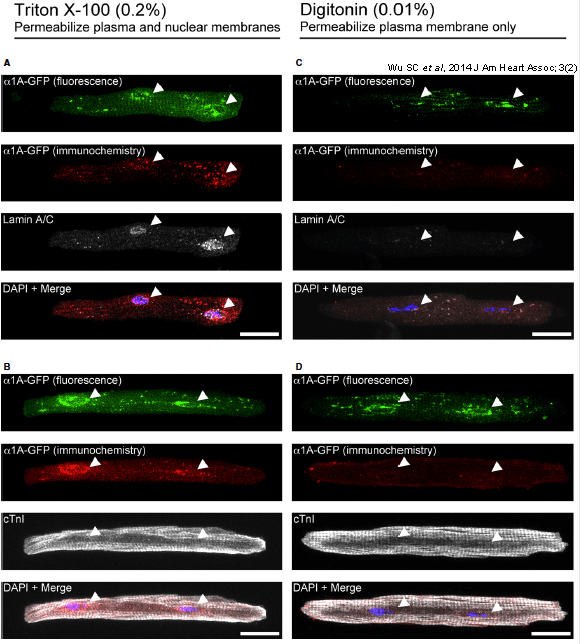The O'Connell Lab
Refuting the Irrefutable Since 2004
Compartmentalization of Gq-coupled Receptor Signaling in Cardiac Myocytes
In the heart, Gq-coupled receptors, including α1-adrenergic receptors (α1-ARs), endothelin receptors (ET-Rs), and angiotensin receptors (AT-Rs), mediate hypertrophy, inotropy, and cell survival, and significantly impact heart failure progression. Furthermore, AT-R antagonists are indicated in heart failure. Conversely, α1-AR antagonists have shown no benefit and actually increased mortality in hypertensive patients.
Recently, we demonstrated that α1-ARs exclusively localize to and signal at the nucleus in adult cardiac myocytes, whereas ET-Rs and AT-Rs primarily localize to and signal at the plasma membrane. Furthermore, our previous studies demonstrate that α1-ARs are cardio-protective, whereas ET-Rs and AT-Rs exacerbate pathologic remodeling in the heart. This suggests that localization of a Gq-coupled receptor in cardiac myocytes might dictate it’s ultimate physiologic function: nuclear Gq-receptors are protective, whereas plasma membrane Gq-receptors are pathologic. This represents a significant paradigm shift in how we consider G-protein coupled receptor (GPCR) signaling.
In this project, we are examining how Gq-coupled receptors signal at the nucleus, using α1-ARs as an archetype for other Gq receptors. We are measuring receptor localization/orientation in the nuclear membrane, what other Gq-signaling proteins localize to the nucleus, mechanisms of nuclear targeting, and measuring Gq-receptor signaling at the nucleus in cardiac myocytes. Second, we are examining the physiologic relevance of nuclear Gq-coupled receptor signaling. We are overexpressing a nuclear localized Gαq to determine if increased nuclear Gq signaling is sufficient to protect cardiac myocytes from pathologic stress. Second, we are developing a mis-localized α1-AR to determine if nuclear Gq-signaling is required for protection.
Lab Publications Relevant to this Project:
-
Dahl EF, Wu SC, Perry J, O'Connell TD 2019. ERK mediated survival signaling is dependent on the Gq-G-protein coupled receptor type and subcellular localization in adult cardiac myocytes. J Mol Cell Cardiol. Feb;127:67-73.
-
Dahl EF, Wu SC, Healy CL, Harsch BA, Shearer GC, O'Connell TD 2018. Subcellular compartmentalization of proximal Gαq-receptor signaling produces unique hypertrophic phenotypes in adult cardiac myocytes. J Biol Chem. Jun 8; 293(23):8734-8749.
-
Wu SC, O'Connell TD. 2014. A nuclear option? G-protein coupled receptors at the nucleus in cardiac myocytes. J Cardiovasc Pharmacol. Dec 30 (Epub ahead of print).
-
Wu SC, O'Connell TD. 2014. Nuclear Compartmentalization of α1-Adrenergic Receptor Signaling in Adult Cardiac Myocytes. J Cardiovasc Pharmacol. Sep 26 (Epub ahead of print).
-
Wu SC, Dahl EF, Wright CD, Cypher AL, Healy CL, O'Connell TD. 2014. Nuclear localization of α1A-adrenergic receptors is required for signaling in cardiac myocytes: an "inside-out" α1-AR signaling pathway. J Am Heart Assoc. 3(2).
-
Wright CD, Wu SC, Dahl EF, Sazama AJ, O'Connell TD. 2012. Nuclear localization drives α1-adrenergic receptor oligomerization and signaling in cardiac myocytes. Cell Signal. 24(3):794-802.
-
Wright CD, Chen QH, Baye NL, Huang Y, Merkwan CL, Kasinathan S, and O’Connell TD. 2008. Nuclear α1-adrenergic receptors signal activated ERK localization to caveolae in adult cardiac myocytes. Circ. Res. 103(9):992-1000.
